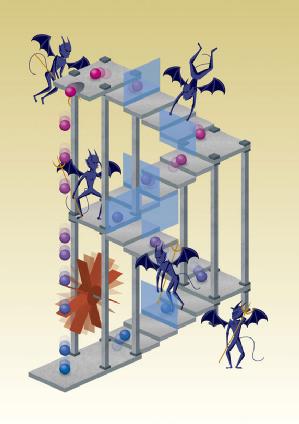Information Thermodynamics of Nonequilibrium Systems
''It sometimes seems as if curbing entropy is our quixotic purpose in the universe.” - James Gleick, The Information: A History, A Theory, A Flood
In 1867 James Clerk Maxwell proposed a famous thought experiment challenging the validity of the 2nd law of thermodynamics. The experiment f eatured a sentient agent - called a 'daemon' and described as a "neat-fingered being" - able to manipulate a themal system based on observation of thermodynamic fluctuations. Through a procedure detailed by Maxwell, this being is capable of exploiting the thermal fluctuations to decrease the entropy of the system without doing any work on it: in essence extracting work from the environment at no cost, violating of the 2nd law.
eatured a sentient agent - called a 'daemon' and described as a "neat-fingered being" - able to manipulate a themal system based on observation of thermodynamic fluctuations. Through a procedure detailed by Maxwell, this being is capable of exploiting the thermal fluctuations to decrease the entropy of the system without doing any work on it: in essence extracting work from the environment at no cost, violating of the 2nd law.
In the past century, much debate has surrounded the rationalisation of this result; from Szilard in 1929, proposing that daemon's own measurements must produce entropy; to Landauer in 1961, highlighting that it is not the measurement but the deleting of information that creates entropy. Many thinkers have realised the importance of information in the understanding of this perceived violation of the 2nd law. Information and Entropy are intricately linked, and by exploring their interrelationship, a more complete understanding of the 2nd law is possible.
Due to recent technological developments, it now possible to experimentally probe the relevant time and length scales on which thermal fluctuations occur. In the pursuit of ever faster and smaller devices, the understanding of these thermal fluctuations has become paramount, and the possibility of exploiting those thermal fluctuations in the operation of our own devices is an exciting prospect for scientists and engineers. The ability to construct our own 'daemons' depends on our ability to understand the complex and often non-trivial information flows and their relationship to the system entropy.
By incorporating information into a thermodynamic framework, the 2nd law can be generalised for cases where some information about a system is being stored/used/deleted to affect the production of entropy in a system. This framework describes the thermodynamic impact of information processing and information exchange between coupled systems (e.g. a thermal system and a 'daemon'). This allows the formulation of novel new thermal models such as the 'information heat engine' and 'information refrigerator' which have been shown to be more efficient than their ordinary thermal or chemical counterparts.
In our interdiscplinary research efforts, we consider models of these systems and attempt to gain insights into the interactions between coupled systems in terms of their information flow. By incorporating ideas from a wide range of fields including large deviation theory; nonequilibrium statistical physics; control theory and information theory, we wish to formulate a physical picture of information flow and develop ideas within the information thermodynamic framework.
References
- Szilard, Leo. ''Uber die Entropieverminderung in einem thermodynamischen System bei Eingriffen intelligenter Wesen." Zeitschrift fur Physik 53.11-12 (1929): 840-856.
- Landauer, Rolf. "Information is physical." Physics Today 44 (1991): 23.
- Sagawa, Takahiro, and Masahito Ueda,. "Generalized Jarzynski equality under nonequilibrium feedback control." Physical review letters 104.9 (2010): 090602.
- Mandal, Dibyendu, H.T. Quan, and Christopher Jarzynski. "Maxwell's refrigerator: An exactly solvable model." Physical review letters 111.3 (2013): 030602.
- Toyabe, Shoichi, et al. "Experimental demonstration of information-to-energy conversion and validation of the generalized Jarzynski equality." Nature Physics 6.12 (2010): 988-992.
- Horowitz, Jordan M., Takahiro Sagawa, and Juan MR Parrondo. "Imitating Chemical Motors with Optimal Information Motors." arXiv preprint arXiv:1210.6448 (2012).
- Image Credit: Mabuchi Design Office / Yuki Akimoto
